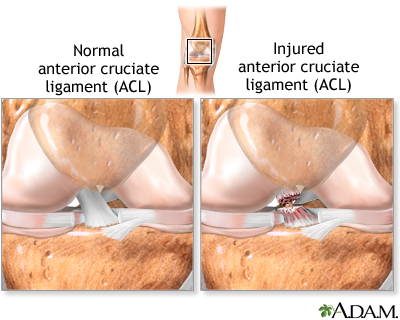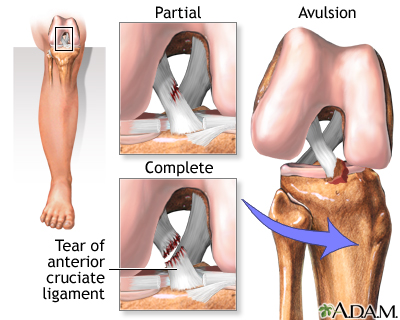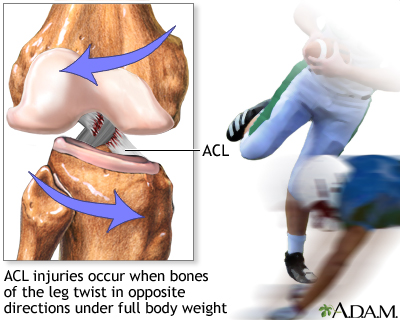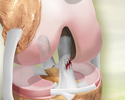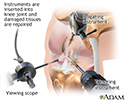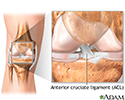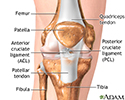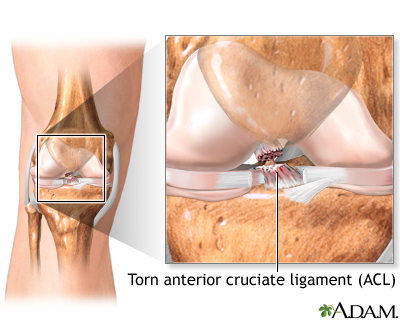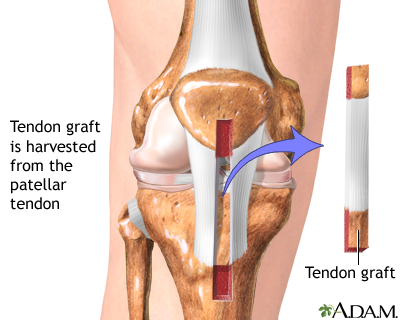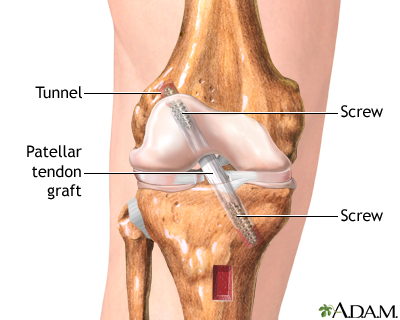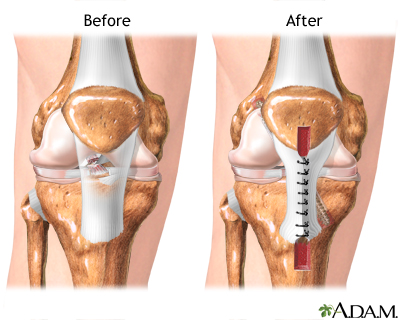Anterior cruciate ligament (ACL) injury
Cruciate ligament injury - anterior; ACL injury; Knee injury - anterior cruciate ligament (ACL)
An anterior cruciate ligament injury is the over-stretching or tearing of the anterior cruciate ligament (ACL) in the knee. A tear may be partial or complete.
Considerations
The knee joint is located where the end of the thigh bone (femur) meets the top of the shin bone (tibia).
Four main ligaments connect these two bones:
- Medial collateral ligament (MCL) runs along the inside of the knee. It prevents the knee from bending in.
- Lateral collateral ligament (LCL) runs along the outside of the knee. It prevents the knee from bending out.
- Anterior cruciate ligament (ACL) is in the middle of the knee. It prevents the shin bone from sliding out in front of the thigh bone.
- Posterior cruciate ligament (PCL) works with the ACL. It prevents the shin bone from sliding backwards under the femur.
Women are more likely to have an ACL tear than men.
Causes
An ACL injury can occur if you:
- Get hit very hard on the side of your knee, such as during a football tackle
- Overextend your knee joint
- Quickly stop moving and change direction while running, landing from a jump, or turning
Basketball, football, soccer, and skiing are common sports linked to ACL tears.
ACL injuries often occur with other injuries. For example, an ACL tear often occurs along with tears to the MCL and the shock-absorbing cartilage in the knee (meniscus).
Most ACL tears occur in the middle of the ligament, or the ligament is pulled off the thigh bone. These injuries form a gap between the torn edges, and do not heal on their own.
Symptoms
Early symptoms:
- A "popping" sound at the time of injury
-
Knee swelling
within 6 hours of injury
Knee swelling
Joint swelling is the buildup of fluid in the soft tissue surrounding the joint.
 ImageRead Article Now Book Mark Article
ImageRead Article Now Book Mark Article - Pain, especially when you try to put weight on the injured leg
Those who have only a mild injury may notice that the knee feels unstable or seems to "give way" when using it.
First Aid
See your health care provider if you think you have an ACL injury. Do not play sports or other activities until you have seen a provider and have been treated.
Your provider may send you for an MRI of the knee. This can confirm the diagnosis. It may also show other knee injuries.
First aid for an ACL injury may include:
First aid
Cruciate ligament injury - aftercare; ACL injury - aftercare
- Raising your leg above the level of the heart
- Putting ice on the knee
- Pain relievers, such as nonsteroidal anti-inflammatory drugs (such as ibuprofen)
You also may need:
- Crutches to walk until the swelling and pain get better
- Physical therapy to help improve joint motion and leg strength
- Surgery to rebuild the ACL
Some people can live and function normally with a torn ACL. However, most people complain that their knee is unstable and may "give out" with physical activity. Unrepaired ACL tears can lead to further knee damage. You are also less likely to return to the same level of sports without the ACL.
Do Not
- Do NOT move your knee if you have had a serious injury.
- Use a splint to keep the knee straight until you see a doctor.
- Do NOT return to play or other activities until you have been treated.
When to Contact a Medical Professional
Call your provider right away if you have a serious knee injury.
Get immediate medical attention if the foot is cool and blue after a knee injury. This means that the knee joint may be dislocated, and blood vessels to the foot may be injured. This is a medical emergency.
Prevention
Use proper techniques when playing sports or exercising. Some college sports programs teach athletes how to reduce stress placed on the ACL.
The use of knee braces during vigorous athletic activity (such as football) is controversial. It has not been shown to reduce the number of knee injuries, and not specifically ACL injuries.
References
Griffin L. The female athlete. In: Miller MD, Thopmson SR, eds. DeLee and Drez's Orthopaedic Sports Medicine. 4th ed. Philadelphia, PA: Elsevier Saunders; 2015:chap 32.
Niska JA, Petrigliano FA, McAllister DR. Anterior cruciate ligament injuries: 1. Anterior cruciate ligament injuries in the adult. In: Miller MD, Thopmson SR, eds. DeLee and Drez's Orthopaedic Sports Medicine. 4th ed. Philadelphia, PA: Elsevier Saunders; 2015:chap 98.
Nyland J, Mattocks A, Kibbe S, Kalloub A, Greene JW, Caborn DN. Anterior cruciate ligament reconstruction, rehabilitation, and return to play: 2015 update.
Open Access J Sports Med.
2016 Feb 24;7:21-32. PMID: 26955296
www.ncbi.nlm.nih.gov/pubmed/26955296
.
-
ACL injury
Animation
-
Knee arthroscopy - illustration
Knee arthroscopy is surgery that is done to check for problems, using a tiny camera to see inside your knee. Other medical instruments may also be inserted to repair your knee.
Knee arthroscopy
illustration
-
ACL degrees - illustration
An injury to the anterior cruciate ligament (ACL) may be described as a partial tear, complete tear or an avulsion (tearing away) from the bone attachments that form the knee.
ACL degrees
illustration
-
ACL injury - illustration
Anterior cruciate ligament (ACL) injuries may occur from coming to a quick stop with a directional change while running, pivoting, landing, or overextending the joint in either direction.
ACL injury
illustration
-
Normal knee anatomy - illustration
The ligaments which attach the upper leg bone (femur) to the large lower leg bone (tibia) create a hinge joint called the knee. The anterior and posterior cruciate ligaments are 2 short, strong ligaments which criss-cross each other in the middle of the joint.
Normal knee anatomy
illustration
-
Anterior cruciate ligament (ACL) injury - illustration
Injury to the anterior cruciate ligament (ACL) is very common and usually the result of a twisting of the leg while applying full downward pressure.
Anterior cruciate ligament (ACL) injury
illustration
-
Anterior cruciate ligament repair - Series
Presentation
-
Knee arthroscopy - illustration
Knee arthroscopy is surgery that is done to check for problems, using a tiny camera to see inside your knee. Other medical instruments may also be inserted to repair your knee.
Knee arthroscopy
illustration
-
ACL degrees - illustration
An injury to the anterior cruciate ligament (ACL) may be described as a partial tear, complete tear or an avulsion (tearing away) from the bone attachments that form the knee.
ACL degrees
illustration
-
ACL injury - illustration
Anterior cruciate ligament (ACL) injuries may occur from coming to a quick stop with a directional change while running, pivoting, landing, or overextending the joint in either direction.
ACL injury
illustration
-
Normal knee anatomy - illustration
The ligaments which attach the upper leg bone (femur) to the large lower leg bone (tibia) create a hinge joint called the knee. The anterior and posterior cruciate ligaments are 2 short, strong ligaments which criss-cross each other in the middle of the joint.
Normal knee anatomy
illustration
-
Anterior cruciate ligament (ACL) injury - illustration
Injury to the anterior cruciate ligament (ACL) is very common and usually the result of a twisting of the leg while applying full downward pressure.
Anterior cruciate ligament (ACL) injury
illustration
-
Anterior cruciate ligament repair - Series
Presentation
-
Creatine
(Alt. Medicine)
Review Date: 4/19/2016
Reviewed By: C. Benjamin Ma, MD, Professor, Chief, Sports Medicine and Shoulder Service, UCSF Department of Orthopaedic Surgery, San Francisco, CA. Also reviewed by David Zieve, MD, MHA, Isla Ogilvie, PhD, and the A.D.A.M. Editorial team.

